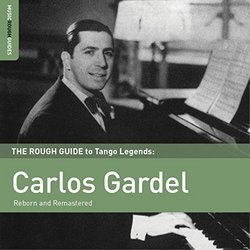| All Artists: Carlos Gardel Title: Rough Guide To Carlos Gardel Members Wishing: 1 Total Copies: 0 Label: World Music Network Release Date: 5/26/2015 Genres: International Music, Pop Styles: South & Central America, Argentina Number of Discs: 1 SwapaCD Credits: 1 UPC: 605633132922 |
Search - Carlos Gardel :: Rough Guide To Carlos Gardel
 | Carlos Gardel Rough Guide To Carlos Gardel Genres: International Music, Pop
?Every day his singing gets better,? say the Argentines about Carlos Gardel. For nostalgic tango lovers all over the world, the passage and dusty patina of time only adds to his value and his beauty. There?s something abou... more » |
Larger Image |
CD Details
Synopsis
Product Description
?Every day his singing gets better,? say the Argentines about Carlos Gardel. For nostalgic tango lovers all over the world, the passage and dusty patina of time only adds to his value and his beauty. There?s something about Gardel that sets him apart from all other artists and musicians, and which keeps him safe and sure in his position as undisputed number one tango legend. But no one quite knows what it is. Born in Toulouse in 1890, Charles Romuald Gardes and his beloved mother, Berthe, sailed to South America in early 1893. They were just two of many thousands of economic migrants trying their luck in Buenos Aires. Berthe made a living as a laundress in the Abasto district. Her son ? renamed Carlos Gardel to fit in ? sang at private parties, and then strummed and sang in a folk duo with José Razzano. In 1912 he recorded 15 folk songs as a soloist. But the key years were between 1917, when Gardel released his tango debut, ?Mi Noche Triste? and launched a genre known as ?tango cancion?, and 1935, when he died tragically in an aeroplane accident in Medellin, Colombia, aged just 44. In this period he released more than 750 songs ? many of which he penned the music for ? visited Europe and the USA, and made eleven feature films, all vehicles for his toothsome smile and his tremulous baritone. He collaborated closely with some brilliant lyricists, most notably Alfredo Le Pera, with whom he would write magisterial tango songs such as ?El Dia Que Me Quieras?, ?Por Una Cabeza? and ?Volver?. The back catalogue is as uneven as it is extensive. But the variation is less in musical and lyrical panache ? Gardel and his various collaborators were Shakespearians, minting new sounds, coining new ideas ? than in the quality of the recordings. Some of the original songs sound small, tinny and fragile, as if played by miniature musicians at the bottom of a gramophone funnel. Others are smoother, slicker, with big orchestras bouncing along and Gardel?s voice revealed in all its range and richness. This selection of tracks is definitive with that caveat in mind. While I have allowed in a few scratchy classics, I have often opted for cleaner tracks that demonstrate the power and presence of Gardel?s voice. What emerges is a multi-faceted talent, a tanguero who sounds sometimes like a romantic hero, sometimes like an old friend, or perhaps a relative, or a cheeky chappy of the barrio, but always a legend. The sequence is driven by mood rather than chronology and paints, I hope, a picture of Belle Époque Buenos Aires and of tango?s golden age, while telling the story of the meteoric rise of Carlos Gardel, ?The Creole Thrush?, ?The Magician?, ?The Quiet Man?, the ?Abasto Brunet? and the eternal ?King Of Tango?.

 Track Listings (27) - Disc #1
Track Listings (27) - Disc #1